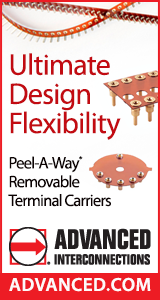|

|
Solder Column Attachment for Absorbing Large CTE Mismatch
Production Floor |
|
Authored By:Martin Hart TOPLINE CORPORATION Irvine, CA, USA SummaryReplacing solder balls with solder columns makes a device known as a Column Grid Array (CCGA). CCGA packages provide a trusted solution for overcoming 10ppm/oC mismatch of coefficient of thermal expansion (CTE) between large ceramic IC packages and glass-epoxy printed circuit boards (PCB). Solder columns are compliant and absorb strain in applications typically found in the fields of military, aerospace and defense where significantly varying temperatures, high vibration and shock are present. Plastic ball grid array (PBGA) packages using solder ball interconnections perform reasonably well in commercial applications. This is not the case with large size ceramic ball grid arrays (CBGA). Solder balls on large CBGA ceramic packages encounter dangerously high stress due to the inherent mismatch between the ceramic's CTE and the PCB. The array of solder balls are stretched and squeezed, especially at the corners of the ceramic substrate and directly under the corners of the silicon die or flip chip. As the temperature swings hot to cold in repeated cycles, the strain induces physical movement in solder balls measured from the neutral point, typically the center of the IC package. While the amount of movement may seem small - about the thickness of a sheet of paper - such stretching may be equivalent to 10% of the overall diameter of the solder ball. Under conditions of repeated thermal cycles, solder balls will delaminate from the IC package and/or the PCB, resulting in catastrophic electrical failure. Replacing solder balls with solder columns provides stress relief on large ceramic area array IC packages. There is also interest to study improvements in reliability by attaching solder columns to large plastic BGA packages as a way to reduce stress for certain applications. This paper reviews the types of commercially off-the-shelf (COTS) solder columns commonly available, including plain Pb90/Sn10 columns, copper wrapped Pb80/Sn20 columns and the NASA invented Micro-coil Spring. This paper also reviews practical ways to attach solder columns and Micro-Coil Springs to IC packages in a high-mix, low volume benchtop environment. ConclusionsReplacing solder balls with solder columns results in a package called a Column Grid Array (CCGA). The CCGA is a trusted package of choice for large area array ceramic packages for surface mounting onto glass-epoxy FR4 (or polyimide) printed circuit boards (PCB). Solder columns are more compliant than solder balls. Solder columns are able to absorb 10ppm/oC mismatch of coefficient of thermal expansion (CTE) when joining ceramic packages to the PCB. The industry has invented creative solutions to improve the construction of CCGA packages over the past forty-years. IBM was the first in the development of CCGA packages in the 1970s using Pb90/Sn10 solder columns. In the 1980s, Raychem innovated the copper wrapped Pb80/Sn20 column. In 2012, NASA invented Micro-coil Springs, constructed with beryllium copper (Be-Cu). Today, most applications in the fields of military, space and defense require the use of tin-lead solders. In the future, nickel-gold plated Micro-coil Springs may provide a reliable pathway to achieving leadfree (Pb-Free) RoHS solutions with SAC305 solder paste. We may see the commercialization of a new generation of thermally enhanced columns constructed by electroplating copper over Pb80/Sn20 (or Pb90/Sn10) rather than by mechanically wrapping copper ribbon. Electroplated copper columns provide an improvement by shortening the thermal resistance path to conduct heat away from the underside of IC packages to massive ground planes in the PCB, instead of depending on top mounted heat spreaders. There is ongoing interest to further understanding ways to improve and innovate new solder columns and attachment processes and to reduce this understanding to practice. Initially Published in the SMTA Proceedings |
|
Comments
|
|
|
|

|


